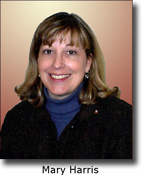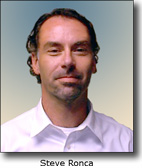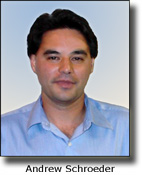“Professional
Liability, Intellectual Property,
and Other Hot Legal Issues”
by
Adele Sommers; photography
by Mary Meyer
 At
this information-saturated session, an expert panel consisting of Mary
Harris, Steve Ronca, and Andrew Schroeder, all local
attorneys practicing in San Luis Obispo or Santa Maria (see speaker
details below), helped us drill into several “burning questions”
about contracts, professional liability, patents, trademarks, copyrights,
and ownership of intellectual property. At
this information-saturated session, an expert panel consisting of Mary
Harris, Steve Ronca, and Andrew Schroeder, all local
attorneys practicing in San Luis Obispo or Santa Maria (see speaker
details below), helped us drill into several “burning questions”
about contracts, professional liability, patents, trademarks, copyrights,
and ownership of intellectual property.
 Due
to the broad nature of these topics, we requested questions in advance
of the meeting. Also, the purpose of this event was to provide general
guidance rather than specific legal advice, which would require in-depth
knowledge of a particular situation. Due
to the broad nature of these topics, we requested questions in advance
of the meeting. Also, the purpose of this event was to provide general
guidance rather than specific legal advice, which would require in-depth
knowledge of a particular situation.
We were
able to address most of the questions to derive some valuable principles
and guidelines. Below is an amalgam of the important highlights we gleaned
from our panelists. Also note that definitions and a list of
resources appear toward the bottom.
 1.
General advice
on
working with an attorney 1.
General advice
on
working with an attorney
2.
Tips for working with a patent
attorney
-
Check
qualifications and methods. When shopping for a patent attorney,
find out if he or she has technical expertise in your area of
focus. A data encryption product may not be well understood by
an attorney with a biology background, for example. Also ask about
fees, whether the attorney outsources work to other groups locally
or in other countries, and what his or her cross-consultation
process is (for complex products that require multiple areas of
expertise).
-
Be
sure to disclose ALL product or process details.
Don't
ask your attorney to rely on vague descriptions or sketches of
your product or process. The more thorough, detailed, and
specific your information is, the better your patent application
will withstand all future challenges.
-
Alternatives
to patents. If you want to avoid the expense and time of obtaining
a patent (which typically costs about $10,000 and three years
of effort), you can consider using a trade secret. While
a trade secret protects and polices your ideas to some extent,
it doesn't protect against reverse engineering. A patent is the
best tool for protecting against idea theft and “fair use”
defenses.
3.
Who owns a product you
created while an
employee?
-
Almost
always, your employer owns it. You can usually count on it if
you used the employer's equipment, resources, facilities, and/or
created the product on work time. If the situation meets only one
of these tests, your employer can still claim ownership. For example,
let's say you borrowed a company laptop and took it home, where
you developed a product of your own. You therefore used company
equipment even though you used it off-site on your own time. If
the product you created relates to what your company does, the company
may want to pursue a claim to the rights to it.
- Independent
contractors generally own their original works of authorship.
Some exceptions may apply.
-
Gray
area: Are you a freelancer or an employee?
The answer could determine who owns the rights to the products you
create. Even if you think you are an independent contractor,
and you have an agreement spelling out the product rights you will
retain, there are certain tests your work situation must meet. The
IRS lists the criteria for determining whether or not you fall into
the employee category. For example, did the client provide
benefits for you? Did you work on your client's site using their
equipment for extended periods without working for other clients?
Check the IRS guidelines to learn about all the tests.
-
When
can you include work samples you created in your portfolio?
Regardless of whether you created a work sample as an employee or
as a contractor, it's always best to request permission in writing
(even via e-mail), which you should save. The company or client
may specify certain conditions, such as “sanitizing” the
products to remove any proprietary information or customer names.
Requesting and receiving permission is better than relying on “fair
use” guidelines, as it's always possible your request may be
denied.
4.
How can you limit
your liability for products
you create on contract?
- You
can limit, but not eliminate, your liability. Although
you can't absolve yourself of all responsibility and liability for
the completeness, accuracy, and safety of the information products
you create for your clients, some limited legal protections exist.
Errors and omissions insurance and carefully worded
contract clauses are two different ways to mitigate the extent
of consequential damages that might result if customers have real
trouble with your products. (Example: a customer misinterprets a key
instruction in a user manual you created for your client's medical
diagnosis software.)
- One
contract clause does not fit all. Just as a flu shot protects
only against certain strains of viruses, a contract clause spelling
out the limits of your professional liability should be tailored to
the situation. Unlike shrink-wrap software, this is an area where
boilerplate disclaimers will not work well. To be sure you are addressing
your situation(s) correctly, you should consult an attorney. Consider
the following:
- How
complicated is the work?
- What
is the nature of the product or process?
- What
background do you and your client each bring to the table?
-
Liability
problems can stem from poor relationships.
Working with clients is all about building relationships. The more
you can support your clients through your personal guarantee of satisfaction,
the more you are likely to maintain positive relationships. As part
of maintaining those relationships, you can take reasonable precautions
by ensuring that your clients review and approve your products before
they are released. Additionally, by having a thorough written agreement,
and a verbal discussion of the key clauses, you will probably
build stronger relationships, even if you also filter out a few clients
along the way.
5.
What protections apply to maps
and collections
of common facts?
-
Originally
created maps, but not the facts they are based upon,
are protected by copyright.
-
If
you are recompiling a collection of maps or common facts,
you should consult an attorney for guidance on copyright issues.
6.
Who owns the rights to a
work compiled from several different
sources?
-
Ownership
of a thing is not the same as owning rights to its components.
If you are creating a compilation involving various components,
you must acquire the rights to all elements you didn't originate
(e.g., in the form of a license) if you want to have rights
to residual sales or other future uses.
-
You
should research the “pedigree” of all components given
to you. If you obtain some graphic or textual material to
incorporate into a product you're creating, you should find
out who owns the rights to those items. For example, is it clip
art with terms of use that say it can be used royalty free,
without attribution, in any form? Or are there strings attached
on how or where it can be used? What rights are reserved by
the originators?
-
If
in doubt, see an attorney.
To get information on where the boundaries of licensing or owning
a particular element begin and end, seek professional guidance.
Once you understand the basic concepts, you may not need repeated
interpretations unless the circumstances change.
7.
What legal
documents should you have on an e-commerce
Web site?
-
You
should have at least the following: Terms of service, privacy
policy, and copyright and trademark notices where applicable.
-
Seek
legal help as needed
to construct these documents or to tailor boilerplate templates.
8.
What are some tips for using
trademarks?
-
Is
registration of a mark required? No. You can establish rights
in a mark based on legitimate use of the mark. However, owning
a federal trademark registration on the Principal Register provides
several advantages, e.g.,
-
constructive
notice to the public of the registrant's claim of ownership
of the mark;
-
a
legal presumption of the registrant's ownership of the mark
and the registrant's exclusive right to use the mark nationwide
on or in connection with the goods and/or services listed
in the registration;
-
the
ability to bring an action concerning the mark in federal
court;
-
the
use of the U.S registration as a basis to obtain registration
in foreign countries; and
-
the
ability to file the US registration with the US Customs
Service to prevent importation of infringing foreign goods.
-
When
can I use the trademark symbols TM, SM and ®? Any time
you claim rights in a mark, you may use the “TM” (trademark)
or “SM” (service mark) designation to alert the public
to your claim, regardless of whether you have filed an application
with the USPTO. However, you may use the federal registration
symbol “®” only after the USPTO actually
registers a mark, and not while an application is pending.
Also, you may use the registration symbol with the mark only
on or in connection with the goods and/or services listed in
the federal trademark registration.
|
Resources:
-
Creative
Commons
(a set of guidelines that offers ways to reserve some, but not
all, rights to a given work): http://creativecommons.org
|
- Patents:
A
patent for an invention is the grant of a property right
to the inventor, issued by the United States Patent
and Trademark Office. Generally, the term of a new patent
is 20 years from the date on which the application for
the patent was filed in the United States or, in special
cases, from the date an earlier related application
was filed, subject to the payment of maintenance fees.
US patent grants are effective only within the United
States, US territories, and US possessions. Under certain
circumstances, patent term extensions or adjustments
may be available. (Source: http://www.uspto.gov/web/offices/pac/doc/general/index.html#ptsc)
- Trademarks
and servicemarks: A trademark is a word, name,
symbol, or device that is used in trade with goods
to indicate the source of the goods and to distinguish
them from the goods of others. A servicemark is the
same as a trademark except that it identifies and
distinguishes the source of a service rather than
a product. The terms “trademark” and “mark”
are commonly used to refer to both trademarks and
servicemarks. (Source: http://www.uspto.gov/web/offices/PAC/doc/general/index.html#mark)
- Copyrights:
Copyright
is a form of protection provided to the authors of
“original works of authorship” including
literary, dramatic, musical, artistic, and certain
other intellectual works, both published and unpublished.
The 1976 Copyright Act generally gives the owner of
copyright the exclusive right to reproduce the copyrighted
work, to prepare derivative works, to distribute copies
or phonorecords of the copyrighted work, to perform
the copyrighted work publicly, or to display the copyrighted
work publicly. The copyright protects the form of
expression rather than the subject matter of the writing.
For example, a description of a machine could be copyrighted,
but this would only prevent others from copying the
description; it would not prevent others from writing
a description of their own or from making and using
the machine. (Source: http://www.copyright.gov/circs/circ1.html#wci)
|
|